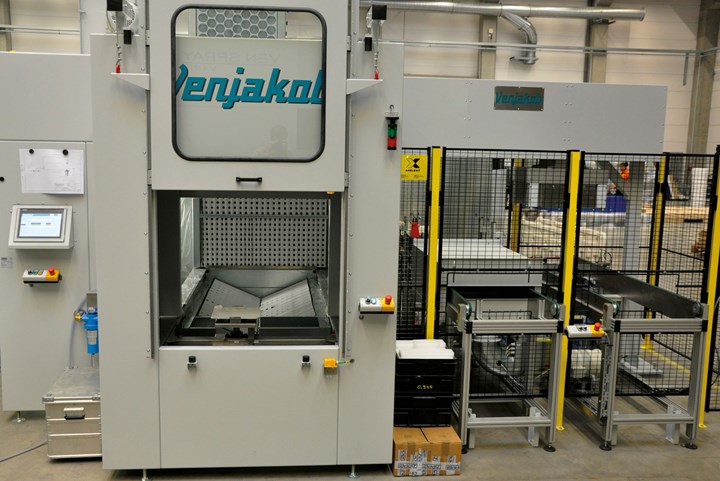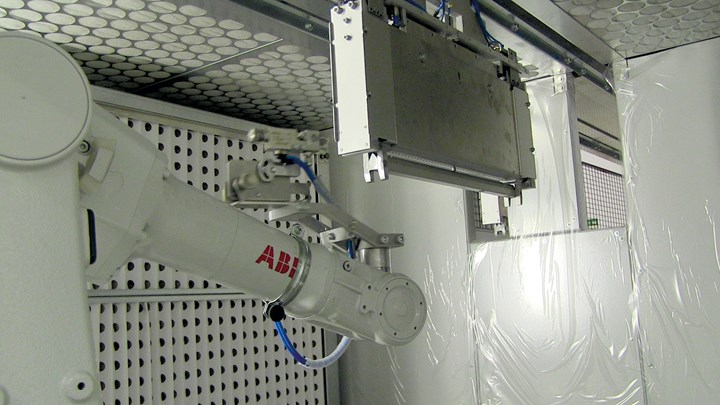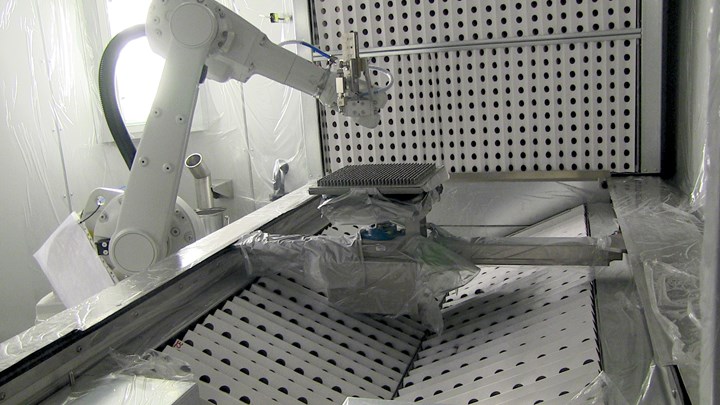
Venjakob’s multi-purpose coating plant was realized in a space-saving way. Photo Credit: all photos courtesy of Venjakob Maschinenbau
A new multi-purpose lacquering system from Venjakob Maschinenbau (Rheda-Wiedenbrück, Germany) was recently put into operation for Aero-Coating GmbH (Wismar, Germany), a service provider specializing in aerospace industry coatings. The company, an affiliate of Eifeler-Holding GmbH & Co. KG (Düsseldorf, Germany), coats components made of metal or polymer materials with functional layers against contact corrosion — typically for businesses in the aerospace sector.
The Venjakob system is suitable for coating screw threads as well as flat and rotationally symmetrical parts.
A need for flexibility
Historically, the components were mounted on special carriers and manually coated. However, this limited the throughput capacity and the finish quality was not reproducible.
The decision was made to invest in a coating system. Because Aero-Coating coats screw threads in high volume, but also flat 3D and rotationally symmetric parts, a very specific requirements profile allowing for flexible application was needed.
Two loading possibilities
Aero-Coating was looking for a compact total system as an island solution with a structured design of the individual assemblies — handling and transport, application robotics, spraying system and booth housing with exhaust and supply air components. The control and formula management should be automated for the most part and operation of the robot should be based on simple programming via copying programs and changing parameters. It should achieve high reproducibility in terms of performance and the quality of the coating — also as regards the uniformity/evenness of the lacquer application while adhering to the coating thickness tolerances.
Venjakob Maschinenbau delivered a 2-in-1 robot application solution — a coating booth with two loading possibilities.

High performance due to the parallel use of two linear axes for the carrier system. Plus high flexibility with regard to the workpieces, the part carriers are flexibly adaptable and suitable for components of various sizes and shapes,
Mode A: Loading with workpiece carrier
In the first operating mode, loading takes place via a special workpiece carrier.
The carriers are manually filled with screws, further conveyed in cycles and transported into the spraying booth via linear axles. A tray is lacquered and complete within 12 seconds. Two linear axles that operate in parallel guarantee high system performance. While one of the two linear axles lingers with one carrier in the coating booth, the other one moves the finished coated components to the flash-off zone or to the discharge, drops them off and returns to the start position to pick up the next carrier. Because only the thread of the screw is supposed to be coated, the area of the linear axle is sealed off around the carrier system and is provided with overpressure during lacquering. To achieve selective coating and to keep over-spray in the booth to an absolute minimum, the robot is also equipped with a spray marking gun, which can atomize the finest amount of coating.
The carrier plates are outfitted with solvent-resistant RFID chips, which are selected prior to entry into the spray booth. The robot can thus retrieve the respective program fully automatically. The component carriers are flexibly adapted and are suitable for components in various sizes and shapes, especially for lacquering small parts. A wide variety of components can be coated with this system design, without having to manually intervene in the system.

For the coating of flat and rotationally symmetrical parts, the system is equipped with a rotary table. The robot needs approximately 1 minute for the coating of the workpieces.
Mode B: Coating on turntables
A turntable was installed in the system, whose rotary function can be activated as needed, for coating flat and rotationally symmetrical components. A vertical separating wall simplifies manual loading and unloading.
The machine operator places the loaded workpiece holder on the turntable. A toothed belt conveyor moves it in front of the lacquering robot and after coating moves it back to its original position for removal.
The robot needs roughly one minute in this mode, depending upon the contour of the workpiece, to lacquer the workpiece. The components can have maximum dimensions of 700 mm x 700 mm x 600 mm.
Compact system
The entire system was realized in a space of only 6.00 m x 4.00 m x 3.70 m (L x W x H). The Siemens-S7 control system is operated via touchscreen. The lacquer programs are stored there as formulas, which can be retrieved manually or fully automatically via an RFID chip.
Venjakob and Aero-Coating worked closely together during the project planning.
Dr. Florian Gehrig, managing director of Aero-Coating says, “The idea for the 2-in-1-solution came from us, as we don’t expect complete utilization of the thread coating for two years, which is why the second feed system was installed, so that in the meantime we can lacquer other components and free up the manual coating booths.”
Venjakob’s expertise guided the realization of this design as well as the selection of the paint feed systems, the application technology and the conveyor technology.
“What seemed important to us was the high level of competence in the selection of paint supply systems and application technology in conjunction with the competence of the handling components,” Gehrig says.
The resulting compact system takes up little space and reduces the amount of solvent used. It also allows for the reduction from four to just one lacquer spray gun, cutting costs and reducing the risk of problems with the lacquer supply.
The entire project took eight months to complete. After the first three months following approval of the concept, work began on the design and construction of the system. The whole design was tried and tested at Venjakob one month prior to delivery. The installation on site took roughly 10 days and certification by Aero-Coating customers was completed after one month.
“Customers immediately confirmed the repeat accuracy and the consistent quality,” Gehrig says. “By using the robot, the sudden 30 percent increase in customer demand was met and overall lead times were reduced by 20 percent.”
Related Content
The Best Method for Coating Full-Size Aircraft
John Owed from Carlisle Fluid Technologies analyzes the difference between using air-assisted airless, air spray and other technologies for coating a full-size aircraft. Which is better?
Read MoreAnodizing for Bonding Applications in Aerospace
Anodizing for pre-prep bonding bridges the gap between metallic and composite worlds, as it provides a superior surface in many applications on aluminum components for bonding to these composites.
Read MoreTop Shop Emphasizes Dedication, Work Ethic
With a primary focus on aerospace and defense work, American Metaseal Corp. of Arbutus, Maryland, has qualified as a Top Shop on multiple occasions.
Read MoreA Smooth Transition from One Anodizing Process to Another
Knowing when to switch from chromic acid anodizing to thin film sulfuric acid anodizing is important. Learn about why the change should be considered and the challenges in doing so.
Read MoreRead Next
Venjakob Unveils Modular Coating Line Concept
Venjakob recently released a case study for a modular coating line concept that allows the individual machines to be equipped according to requirements, which can be upgraded with additional functions at any time.
Read MoreAR-Service App from Venjakob
The AR-Service app allows technicians to communicate with onsite technicians to make recommendations or address system issues.
Read MoreDelivering Increased Benefits to Greenhouse Films
Baystar's Borstar technology is helping customers deliver better, more reliable production methods to greenhouse agriculture.
Read More























